A Ukrainian town devastated by the invasion defends its Soviet legend
The municipality of Sviatohirsk is known for hosting the largest statue dedicated to the Bolshevik revolutionary Artyom, a symbol of Russian nationalism in Donbas

The colossal figure of a Soviet legend presides over the Ukrainian municipality of Sviatohirsk, in Donetsk province: Artyom, the name by which the Bolshevik revolutionary Fyodor Sergeyev was known. His effigy, like the rest of the village, has not been spared the destruction caused by the fighting during three months of Russian occupation from June to September 2022. The monument, 22 meters high and located on a hill overlooking the area, was hit by mortar and bullet impacts. Around it lay excavated machine gun nests, abandoned ammunition boxes, and minefields. At its feet is a Ukrainian flag raised by soldiers when Sviatohirsk was liberated. The wind later blew it from the statue and no one raised it again. It is a sculpture dedicated to a myth of Russian imperialism, but also a work of art that Ukraine wants to preserve.
The monument to Artyom is the work of Ivan Kavaleridze (1888-1978), one of the most prominent Ukrainian sculptors of the early 20th century. That is what saved the statue from the “decommunization laws” passed in 2015, as Oksana Barshynova, deputy director of the National Art Museum of Ukraine, explained in the catalog of the exhibition In the Eye of the Hurricane: Avant-garde in Ukraine 1900-1930 (2022). The war with pro-Russian separatists in Donbas intensified the eradication of Russian imperialist and Soviet influence in Ukraine. Since the invasion of 2022, the process has accelerated. “Since 2015, the Kavaleridze monument has been under threat of demolition, but its durability and technological sophistication saved it from destruction,” wrote Barshynova.
The Ukrainian Ministry of Culture found an alternative last October, when the 1927 sculpture was renamed “Monument of the outstanding sculptor Ivan Petrovich Kavaleridze.” But the reality, as Barshynova pointed out, is that it is impossible “to separate the ideology in Kavaleridze’s monumental works.” The artist himself wrote that he approached the sculpture in Sviatohirsk with “great enthusiasm.” “It was important to personify the energy and will of all those who were building socialism. With his left hand, Artyom clutches his cap, and with his right hand he points the way to the masses,” said Kavaleridze. “The figure is seen in the distance, and personifies the rise of the young, industrial Donbas.”
The statue is exceptional for its time, a cubist figure carved from a single piece of concrete. Even more ambitious was the monument to Artyom that Kavaleridze built in 1924 in Bakhmut. The city was rechristened Artemovsk the same year, in honor of the late Bolshevik leader, and was so named until Ukrainian independence, when it readopted its pre-Soviet name. Artyom’s sculptural complex in Bakhmut was destroyed during the German occupation in World War II. The city was razed to the ground between 2022 and 2023, during the current invasion. For Russia, which has occupied the ruins of Bakhmut, the municipality continues to be named Artemovsk.
“Hateful Bolshevik”
Comrade Artyom was one of the most charismatic revolutionaries in Ukraine, especially in the mining region of the Donbas. After his death in 1921 in an accident, the Communist Party elevated him to the top of the Soviet iconic Olympus and Stalin went as far as adopting his son. Artyom also fought against Ukrainian nationalism and against the proclamation of the short-lived Ukrainian republic. For the authorities in Kyiv, his figure embodies the enemy who denies the existence of the Ukrainian state; for the Kremlin, Artyom is the proof that Ukraine is part of its sphere.
The Donetsk regional government last October organized a meeting between experts and the media to justify the renaming and preservation of the statue. The provincial government invited artist Rostyslav Luzhetskyi, an admirer of Kavaleridze, to speak to the press and he indicated that it is almost coincidental that the sculpture is a tribute to Artyom: “For Kavaleridze it was just an opportunity to create something great.” The statement of the Donetsk authorities continued: “Luzhetskyi stated that the monument has nothing to do with the real image of the hated Bolshevik, neither the portrait nor his anthropology. Physiognomists who studied the monument say it is much more similar to the young Kavaleridze.”
But the story is what it is; it is a monument to Artyom. And those who know it best are the inhabitants of Sviatohirsk. “We are in a time of decommunization, but we also have to preserve history,” Volodymir Rebalkin, the mayor, told this newspaper last February. Rebalkin acknowledged the complexity of the situation, “because the sculpture has the value that it is Kavaleridze’s, from the good old days of the USSR [the 1920s were characterized by a revaluation of Ukrainian national culture], but it is also about Artyom, a symbol of terror.”
Most importantly for Rebalkin, the sculpture is a hallmark of one of Ukraine’s most popular tourist destinations. Sviatohirsk today is a desolate place, its forests ravaged by fighting and many of its buildings torn to shreds, but before the war it had been a destination for nature and health tourism. Serhii is a retired machinist who talks to EL PAÍS in front of the ruins of a building in the center of the village. In the background, the constant thump of Ukrainian shells firing towards Russian positions, 15 miles away, can be heard. For Serhii, Artyom “was a great hero,” and it was by his will that Sviatohirsk became a place of leisure for Donetsk mine workers. Serhii does not want to give his opinion on what significance the monument holds for the two sides fighting today, merely stating that “no one is spared from war and sadness.”
“For my generation it is a tribute to a hero, to Artyom. For young people it will be a different thing,” says Valentina Antipova, a 75-year-old retired agronomist who lost her husband during the current war, in an artillery bombardment. Antipova waits in a coffee shop for a friend to drive her home. She sips a cup of tea as she sadly recalls her youth, not nostalgic for the Soviet Union, but comparing it to the decade that the Donetsk province has now been at war: “For my generation, it is difficult to adapt to the new times.”
Sign up for our weekly newsletter to get more English-language news coverage from EL PAÍS USA Edition
Tu suscripción se está usando en otro dispositivo
¿Quieres añadir otro usuario a tu suscripción?
Si continúas leyendo en este dispositivo, no se podrá leer en el otro.
FlechaTu suscripción se está usando en otro dispositivo y solo puedes acceder a EL PAÍS desde un dispositivo a la vez.
Si quieres compartir tu cuenta, cambia tu suscripción a la modalidad Premium, así podrás añadir otro usuario. Cada uno accederá con su propia cuenta de email, lo que os permitirá personalizar vuestra experiencia en EL PAÍS.
¿Tienes una suscripción de empresa? Accede aquí para contratar más cuentas.
En el caso de no saber quién está usando tu cuenta, te recomendamos cambiar tu contraseña aquí.
Si decides continuar compartiendo tu cuenta, este mensaje se mostrará en tu dispositivo y en el de la otra persona que está usando tu cuenta de forma indefinida, afectando a tu experiencia de lectura. Puedes consultar aquí los términos y condiciones de la suscripción digital.
More information
Archived In
Últimas noticias
The complicated life of Francesca Albanese: A rising figure in Italy but barred from every bank by Trump’s sanctions
Pinochet’s victims grapple with José Antonio Kast’s rise in Chile
Reinhard Genzel, Nobel laureate in physics: ‘One-minute videos will never give you the truth’
How Japan is trying to avert ‘digital defeat’
Most viewed
- Pablo Escobar’s hippos: A serious environmental problem, 40 years on
- Reinhard Genzel, Nobel laureate in physics: ‘One-minute videos will never give you the truth’
- Why we lost the habit of sleeping in two segments and how that changed our sense of time
- Charles Dubouloz, mountaineering star, retires at 36 with a farewell tour inspired by Walter Bonatti
- The Florida Keys tourist paradise is besieged by immigration agents: ‘We’ve never seen anything like this’










































